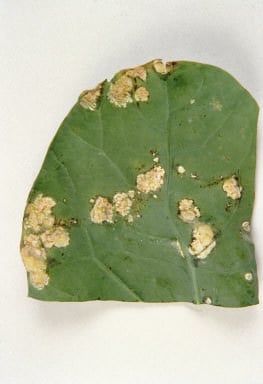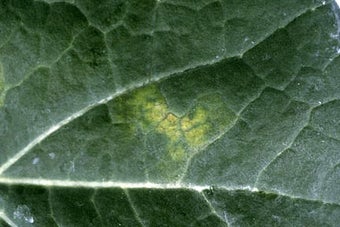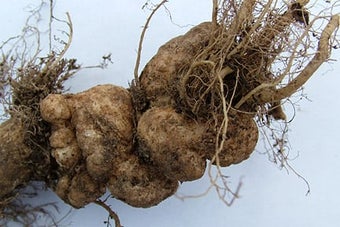
Quick facts
Common name - White blister
Scientific name - Albugo and Pustula species
Plants affected - Members of the Brassicaceae, Asteraceae and Aizoaceae
Main symptoms - White pustules producing powdery spores on leaves and other aerial parts. Growth is often distorted
Caused by - Fungus-like (Oomycete) organisms
Timing - Seen most commonly in spring and summer, although it can be found year-round on biennials/perennials, vegetable brassicas and indoor plants
What is white blister?
White blister is a foliar disease caused by species of Albugo or Pustula. These are fungus-like (Oomycete) organisms closely related to those causing downy mildew diseases. On some plants, such as brassicas, white blister and downy mildew infections may occur together. Like downy mildews, infection and spread of white blister is favoured by wet weather.
Due to the spore pustules that they produce white blisters are sometimes also known as white rusts, although they are unrelated to the fungi causing true rust diseases.
Symptoms
You may see the following symptoms:
- Pale leaf spots form, which eventually develop into blister-like white pustules releasing huge numbers of tiny, powdery spores
- The pustules are usually found on the underside of the leaf, and may develop singly or in concentric rings
- There is often abnormal pigmentation (e.g. purpling) surrounding the affected area
- Other aerial parts, such as stems, flowers and seed pods can also be attacked
- Affected plant parts are often distorted, resulting in bulges or sunken pits on leaves, curved stems and abnormally-shaped flower heads or seed pods. Brussels sprout buttons develop conspicuous protrusions where white blister is present
- Vigour is reduced and severely-affected plant parts can shrivel and die

Control
Non-chemical control
- Remove affected plant parts, and dispose of severely infected plant material
- Avoid close spacing of plants, which encourages high and infection
- Remove weed hosts of the disease (although see the comment under ‘Biology’ regarding species of Albugo and Pustula)
- Crop rotation may help to reduce the incidence of the disease
- Seed catalogues list cultivars with resistance or tolerance to white blister including Brussels sprout ‘Bridge F1’ listed as resistant, and 'Doric F1', ‘Exodus F1’, ‘Maximus F1’ and the broccoli ‘Green Magic’ noted as having good tolerance
Chemical control
There are no fungicides available to amateur gardeners for the control of white blister diseases.
Biology
A number of species of Albugo and Pustula may be found in gardens:
Members of the Brassicaceae, including vegetable brassicas and ornamentals such as honesty, aubretia and Aurinia saxatilis, are affected by Albugo candida. Other Albugo species may also be involved. The disease is also seen frequently on the cruciferous weed shepherd’s purse. On many of these plants it can sometimes be found in close association with downy mildew.
Members of the Asteraceaeare affected by Pustula species. Once again it is likely that a number of different species of the pathogen are involved. White blister is the most important disease of salsify and scorzonera, and is found on ornamentals such as Senecio cineraria, gerbera, florist’s cineraria (Pericallis × hybrida) and sunflower. Weeds that can be affected include ragwort, groundsel, goat’s-beard and creeping thistle.
Albugo trianthemae was recorded for the first time in the UK in 2007. It affects the Aizoaceae, and has been found on Delosperma and Lampranthus.
The life-cycles of the various Albugo and Pustula species are very similar. The microscopic spores released from the white pustules are dispersed by rain splash, insects and in air currents. They require leaf wetness in order to germinate and produce a second spore type, which infects the plant through its air pores ( ).
A third type of spore is formed within the affected plant tissues. This is a resilient resting spore, which can contaminate the soil for several months and germinate to infect new plantings of susceptible hosts. The disease can also be seed-borne.
It is now thought that there are actually many more species of Albugo and Pustula than was previously realised. Until this situation is clarified it is unclear how readily the disease can spread between different plant species in the same family.









